Why background noise at home is driving us mad – and how to get away from it


Why background noise at home is driving us mad – and how to get away from it
The chugging, huffing, whirring or gurgling of our homes and interiors can feel deafening and distracting, but there is another way to live
By JENNY TUCKER for THE TELEGRAPH
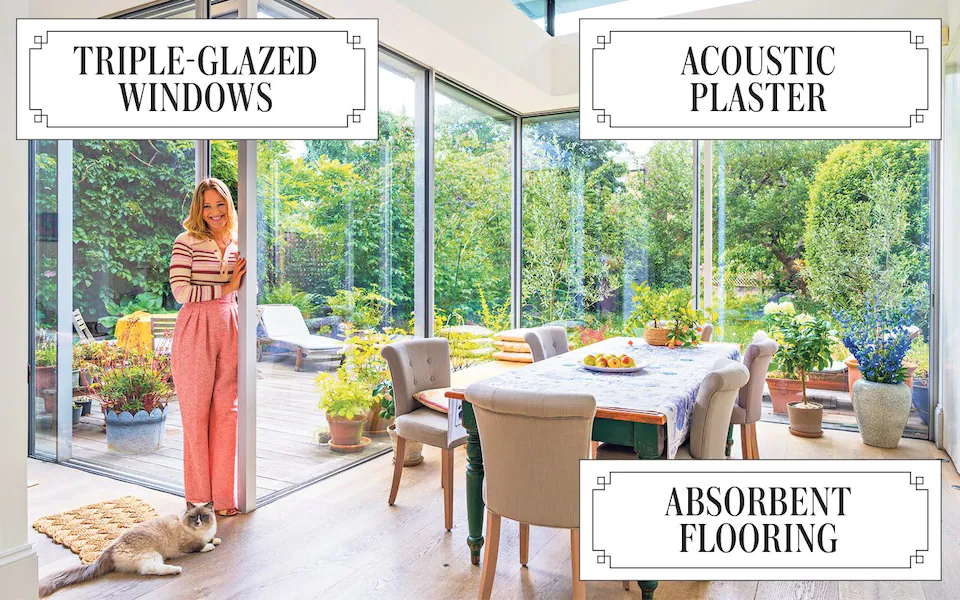
Poppy Szkiler, pictured at her home in south London, is founder and CEO of Quiet Mark (CREDIT: Andrew Crowley)
Just the other day, I was working from home while my two young adult sons were both isolating. One was on the PlayStation obliterating endless Action Man types, while the other was blasting old-school Pulp from his Spotify. Meanwhile, in the kitchen, the tumble drier was humming, the oven fan was droning, the kettle was bubbling and my email was ping-ping-pinging. Suddenly, my two dogs, who must have detected a murmur only accessible to canine ears (how overwhelming must this modern world be for our pets?), started barking like loons. In a fit of acute tension, I bellowed at them, “Be quiet!” (Yes, I am aware of the irony).
Our world today is thick with noise. Everything is either bleeping, chugging, huffing, whirring or gurgling. There aren’t enough verbs to describe it all. And while most of us have conditioned ourselves to live alongside it, there are repercussions. On a daily basis, when we are exposed to a loud or sudden sound, our primary stress hormone, cortisol, kicks in and anxiety surges – we all know how agitated we can get when there is an onslaught of tech and electronic chatter. The World Health Organisation says that noise pollution has a considerable detrimental effect on our wellbeing, and is second only to air pollution as the world’s largest killer pollutant.
Noise is also a significant distraction. It blurs the edges of clarity and stymies our thought process. Studies have shown that continuous background noise plays a negative role in the development of child learning capabilities. While a British Journal of Psychology study found, whether reading or writing, invasive sound killed productivity. From personal experience, I always notice how my mind wanders off on amazing tangents whenever I am immersed in silence for lengthy periods of time. Once the outside world is muffled, the power of the creative brain is liberated.
So, what can we do to turn down the volume on our lives? Much of it is about personal choice, especially when it comes to our homes and the way we want to exist. Since the pandemic, and the enforced time in our four walls, people are more conscious of the hullabaloo their environment creates. Simon Gosling, CMO of Quiet Mark, a certification programme for quiet products, says,
“Our homes are getting noisier due to mass consumerism and tech. There is so much stuff available, but most of it makes a racket. Products are often created with their aesthetic appeal in mind, however we’re seeing a growth in manufacturers prioritising quiet innovation to improve the sound of their appliances. Consumers are getting increasingly savvy about what they buy.”
Taking noise abatement a step further, Quiet Mark recently launched their Acoustics Academy platform, an online guide to inform architects, building specifiers and homeowners on the best acoustic building materials and interiors.
“There are all sorts of incredible advances out there,” reveals Simon, “Like sound reduction floors and walls, special acoustic plaster which can be used in ceilings, and lighting and furniture that absorbs noise… When a home is being built or renovated from scratch its sound design can now be at the top of the list. We’ve all sat in those kitchens with hard flat surfaces where you feel you’re in an echo chamber. That doesn’t have to be the case.”
And if you want the whole package, coming soon: the Kiss House. A new modern style of home, pre-designed and built to Passivhaus international gold standard for ecological efficiency. Mike Jacob, Director of Product and Innovation, says: “These homes have such high levels of installation and attention to detail, you feel cocooned from any external noise pollution. There is a deep sense of privacy, comfort and quality.”
But if moving home, or even renovating, isn’t on your agenda right now, there are easier things we can all do to lower the tone. Creating a sense of serenity might simply mean altering your colour palette to softer hues, or bringing nature into the home with a display of plants, or conceiving a quiet nook where you can unplug and be still. It might just be thinking about what you can let go. Do you really need a TV in the bedroom? A whizzy toothbrush in the bathroom? Or Alexa backchatting your every request?
Ayshea McCormack, founder of The Small Home, an online shop committed to paired-back ethical products, is mindful about her own interiors. “I select shades of white as a backdrop for my rooms, and I love the paint brand, Atelier Ellis. They have the most exquisite different whites - Warm White is my all-time favourite. It’s also important for me to create zones where one can retreat. We have an unspoken house rule that this is a place you can go to withdraw, to read or write undisturbed. I have a pair of noise cancelling headphones in my calm corner which I wear regularly with nothing playing through them - just to remind my family I don’t want to be interrupted!”
Muting life should not be seen as turning your back, but simply a chance to take a breath. Because when the volume is lowered, it might just be quiet enough to hear what’s really going on around you.
‘Silent except for the soporific trickling of the fountain’
Sue Ashton is a garden designer based in Burford, Oxfordshire. Her conservatory is a legacy from her parents, and the place where she retreats from the hubbub of the world
There’s one word to sum up Sue Ashton’s garden conservatory: enchanting. Bursting with greenery, dotted with blooms and silent except for the soporific trickling of the fountain in one corner, it truly is a haven. Sue moved to this house 11 years ago after her parents passed away; the garden and conservatory had always been the family’s much-loved homage to nature.
“My mother was a botanist and both she and my father were keen gardeners,” reveals Sue. “When they bought this house in 1985, there was a dilapidated Victorian glass orangery but it was too rundown to restore, so my father had this conservatory built to his specifications. A fountain was installed and the space divided into two parts: a cool end to grow his favourite auriculas, and a larger section with a fireplace to help support more exotic plants.”
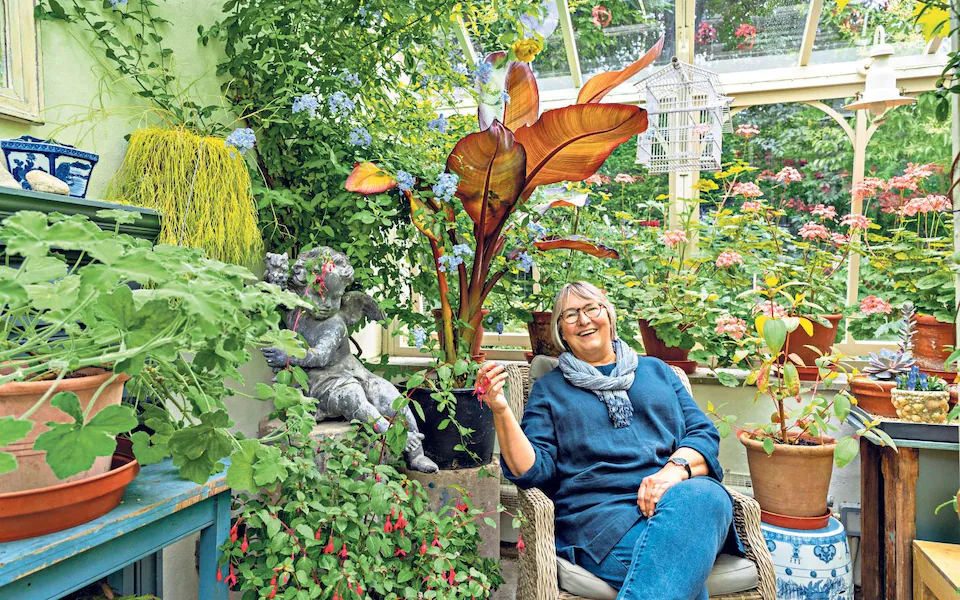
Sue's conservatory is her special quiet retreat from the noisy world outside (CREDIT: Andrew Crowley)
As a designer, Sue spends a lot of her time on various sites where, she says, she sees gardens turned into mud pits and stripped of foliage before being transformed to create a client’s dream landscape.
Returning to her conservatory always acts as a reassuring constant in her life. “I enjoy the thought that I am continuing the process started by my parents; I think about them a lot when I am in here,” she says. “I also love the fact that it is forever either in bloom or awash with greenery. Like now, there are tons of ferns, succulents, pelargoniums, grape vines and a beautiful blue plumbago. Glorious.”
From spring onwards, when the weather starts to warm up, this space serves many purposes. Sue and her husband will often eat in here, or sit reading, or even entertain friends with a glass of wine in the evening. (“It looks beautiful lit up with loads of candles.”) But most of all, Sue retreats to her conservatory to soothe her mind. “I do a lot of pottering,” she laughs.
“When I am alone, immersed in my tending, it completely calms me. To keep a happy-looking conservatory going, a lot of fiddling is required. But it’s the best way to relax and stops me thinking about all the other issues running through my mind. There’s a quote by the philosopher Ralph Waldo Emerson, which goes something like: “Serenity is not freedom from the storm, but the peace within the storm.” That’s how I feel when I retreat to my conservatory. I am at peace there.”
Sue opens her garden by private arrangement in aid of local charities
‘Whenever I can, I’ll sit in this room and take time to pause’
Shalini Misra, is an interior designer specialising in holistic and biophilic design. The family home in northwest London is testimony to her style
“It’s extremely important for me to be connected to nature,” reveals Shalini, “so when I designed this garden room, I wanted floor-to-ceiling windows so that the inside would blend with the outside. We’ve been in this house 20 years; the family before lived here 30 years and they put a lot of energy into the 150ft garden. There are incredible mature trees everywhere: red beech, oak, silver birch, chestnut; it’s so wonderful to relax in this room and absorb that view.”
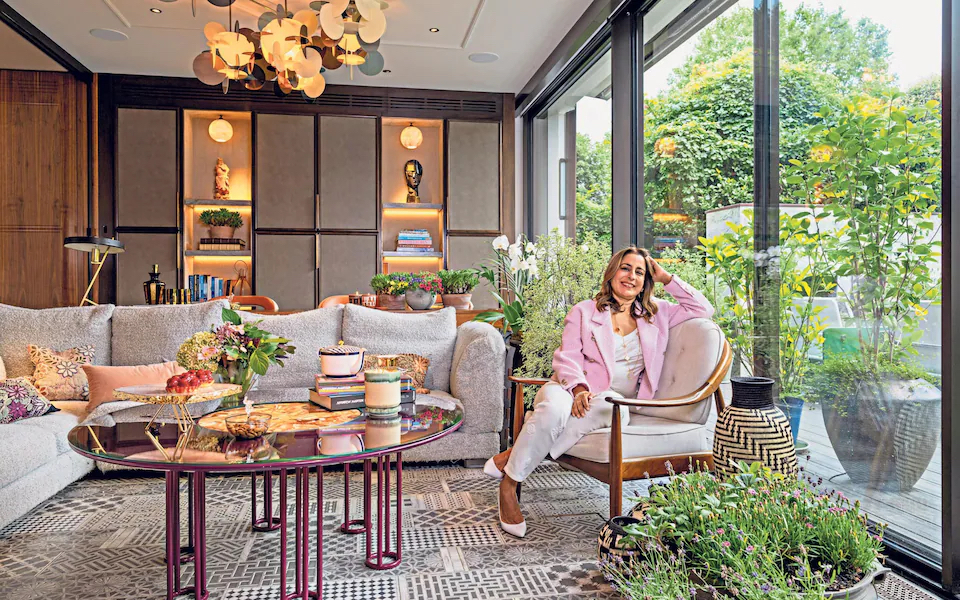
With three children and a busy career, Shalini’s life is packed, which makes it even more crucial that home is a space of calm (CREDIT: Andrew Crowley)
Shalini is drawn to this space when she wants time out, so it was crucial for the interiors to exude comfort and calm. “I’ve chosen soft colours and a mix of tactile textures, two vintage 1950s chairs for their lived-in factor, and an Italian Fornasetti floor with a distinctive pattern, which actually reminds me of the twigs and branches in the garden. As a practitioner of luminotherapy, considered lighting is key, so I’ve included a chandelier which gives a more subtle glow and works as a focal point for the room. I love anything upcycled – the sofa was an old Flexform design, which I had reupholstered. It’s so well-worn and comfy; my absolute favourite thing is to cosy up on it and read a book.”
As a designer, surrounded by beautiful interiors and exposed to a continual stream of the latest accessories, Shalini makes a conscious decision to balance her work with sustainable products. “I am always on the lookout for striking vintage items,” she says. “Alfie’s Antiques near to my home is a favourite. I find repurposing items an absolute joy – if there is the chance to repaint something, add a different handle, or change the material, I will. Plus I am an advocate for locally sourced products. When I design homes in the UK, I try to choose British – there are forests here growing sustainable timber. Then when I am in India, I encourage clients to buy from our own craftsmen and designers. My house in Delhi was built and decorated with everything sourced in India.”
With three children and a high-profile career, Shalini’s life is jam-packed. Taking a moment to stop, breathe and enjoy the peaceful view is integral to her wellbeing. “I am someone who is always buzzing with ideas and considering what may come next,” she laughs. “So to ground me I meditate and practice yoga every morning. Then, whenever I can, I’ll sit in this room and take time to pause. Just the process of actively slowing down helps to organise my brain and focus my thinking. Then I am ready to get on with my day.”
‘When I’m designing my home, I think about the soundscape’
Poppy Szkiler is the co-founder and CEO of Quiet Mark, the independent global certification programme which identifies the quietest home appliances and tech, building sector materials and commercial product noise reduction solutions. Poppy works from her home in south London, where she lives with her husband Paul, CEO of Truestone, and cat, Elijah.
The crusade for a quiet environment is in Poppy’s DNA. Her grandfather, John Connell OBE, founded the Noise Abatement Society in 1959, a charity which campaigned against noise pollution.
“Funnily enough,” laughs Poppy, “I believe my grandfather wrote to The Daily Telegraph in the 1950s, asking if anyone else was experiencing the significant increase in noise. The newspaper published his letter and loads of replies poured in, supporting him.”
An extension of the charity, and co-founded at the kitchen table with Poppy’s mother, Gloria Elliott OBE, Quiet Mark came about in 2012 as the next step in understanding how noise impacts our mental and physical health, and what alternatives we can choose to alleviate the crescendo.
“There is much wonder and comfort to living in a quiet space,” says Poppy. “We need a release from the constant bleeping.”
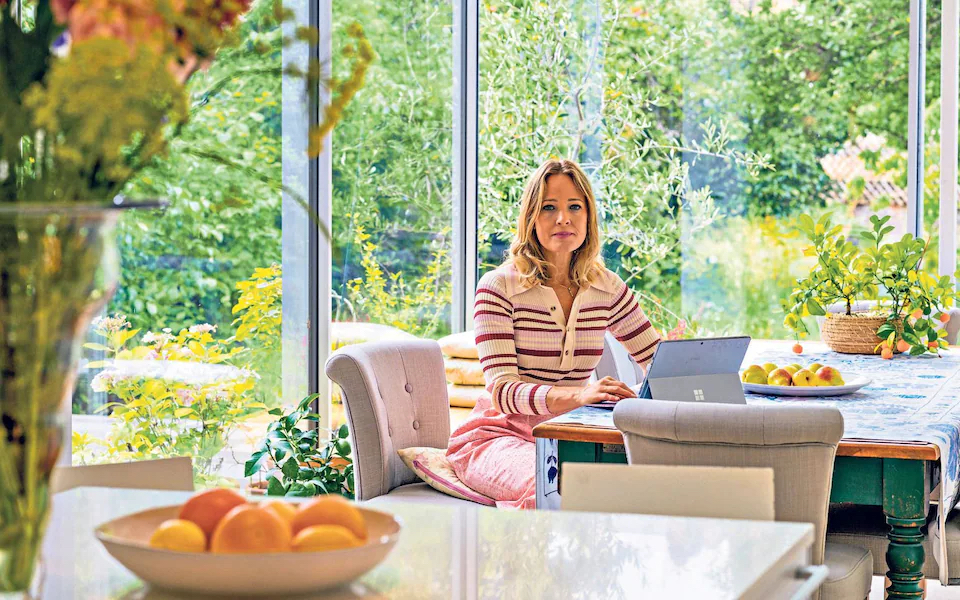
Poppy has added all kinds of additions to her home to increase aural comfort, such as triple-glazed windows and a quiet extractor fan (CREDIT: Andrew Crowley)
Poppy reveals that sound awareness is rapidly moving into the public’s consciousness.
“We have various partnerships with retailers, such as John Lewis who tell us they have over 10,000 online searches for quiet products every month. Our expert teams of acoustic consultants test and verify products, checking the claims of manufacturers.
“It is a complex, scientific and lengthy process which includes measuring decibels, frequency, tone and overall sound quality, culminating in our unique extensive database of acoustic performance for over 80 product categories.
“We really are very geeky, and if something is recommended by Quiet Mark, you know it has been put through its paces. Yet we never name and shame; we simply feature the top 10 to 20 per cent of the best on the market each year to make it super easy for the consumer to choose well by looking out for our Quiet Mark ‘Q’ stamp of approval.”
In her own home, Poppy has sound reduction at the top of her priority list. Although, she says, visitors may not notice anything visually different when they walk in, there are all kinds of thoughtful additions to increase aural comfort: triple-glazed windows, absorbent flooring, special acoustic plaster, a quiet extractor fan and, of course, an array of discreet appliances. She has even created a beautiful wild garden, seen from her kitchen, to encourage the lulling comfort of birdsong.
“When I’m designing my home, I don’t think immediately about the look, I prioritise the soundscape,” she says. “In this house, I’ve created a modern monastic feel, lots of white space and less things; a sanctuary to feel at peace in.
“For me, silence is crucial. It takes me back to what is most important. And when I sit in quiet, I have my best thoughts; I can find the answers. Especially now, when the world feels so strange, what I experience in quietness is my life source.”
Certified by Quiet Mark
The quietest appliances
- Dualit Classic Kettle, £129.99
- Liebherr ICBNdi 5183 Peak BioFresh NoFrost Integrable Fridge Freezer, £2,879
- Miele WEG 665 WCS TDos 9kg Washing Machine, £999
- Novy Panorama Power Vented Downdraft Induction Hob + Hood, £3,499
- MeacoFan 1056 Air Circulator, £99
- AirCraft PowerGlide Cordless Hard Floor Cleaner from Lakeland, £199.99
Building products from their Acoustics Academy
- Flooring: Karndean Korlok Luxury Vinyl Tile Flooring, £43.95 psm
- Windows: Internorm UK triple glazed windows. For bespoke quotes: uk.internorm.com
- Walls: WoodUpp Akupanel Decorative Wood Acoustic Panels, from €135
- Lighting: BuzziSpace BuzziProp Acoustic Pendant Lighting, from £933.28
How to live peacefully side by side…
If you live in a property that is attached to your neighbours’, you will be likely to hear each other from time to time. So, if you are doing something that is noisy (home DIY), think about the time of day you are doing it and the effect the noise may be having on them
If you are holding a party, invite the neighbours – they will be less likely to complain about the noise if they are with you!
If you are bothered by noise from your neighbours, speak to them about it first. They may not realise the noise is causing you a problem
If talking doesn’t help, you can complain to your local authority’s environmental health team. They will come and investigate to see if you are experiencing a noise nuisance. The noise must be affecting you quite badly for a nuisance to be found, so simply hearing your neighbours will not cut it
The same principle applies to noise from nearby commercial or industrial premises. Speak to them first and, if that doesn’t work, contact your local authority. In this case, however, even if a nuisance is found, it does not necessarily mean the noise will be reduced as there is a defence of Best Practicable Means, which recognises when the noise-maker has done all they reasonably can to mitigate the impact
Further information can be found at: Institute of Acoustics, the Association of Noise Consultants, Chartered Institute of Environmental Health, the Royal Environmental Health Institute of Scotland. Courtesy of Stephen Turner – President of the Institute of Acoustics
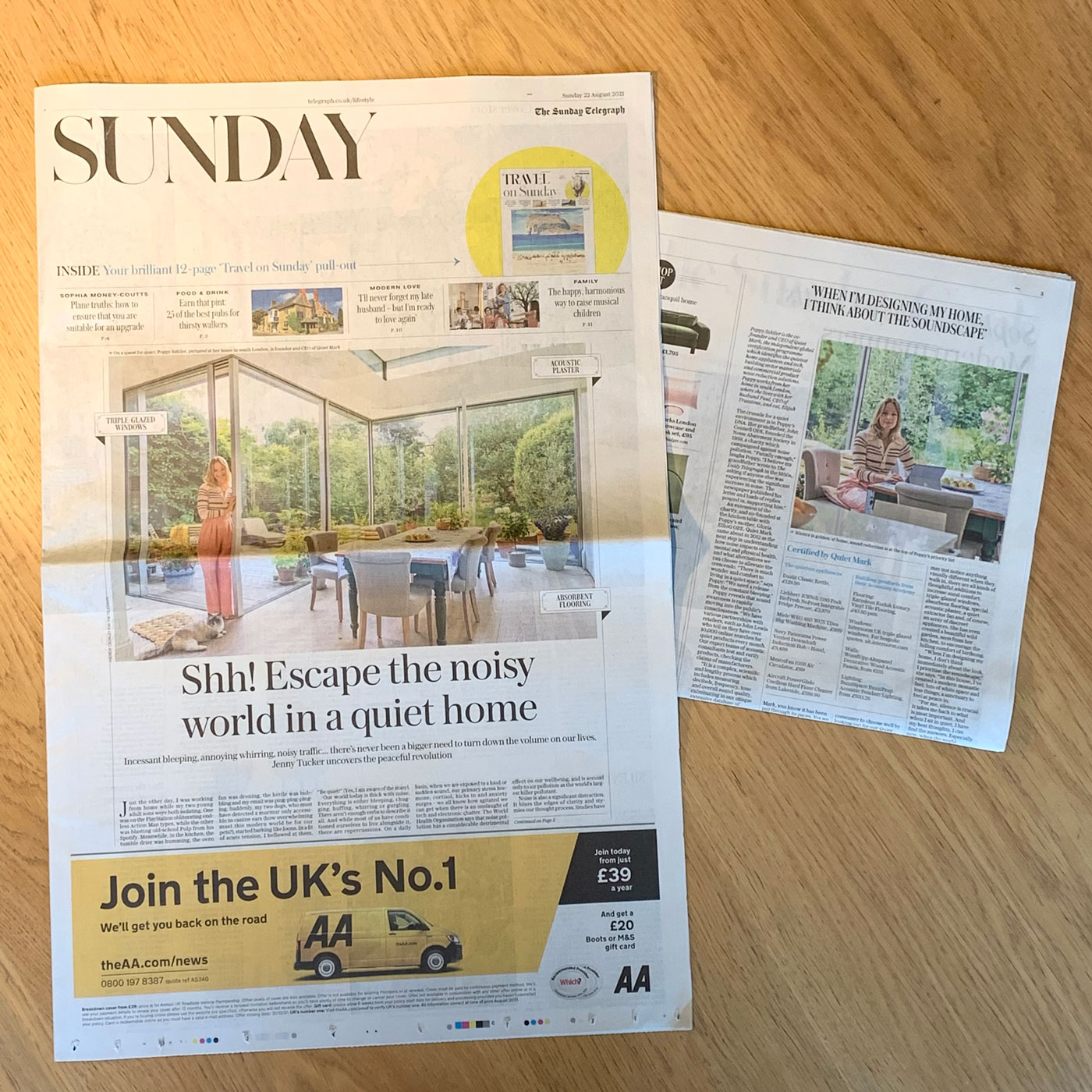
Read the original article in the 22nd August 2021 print issue of The Telegraph or on their website here.

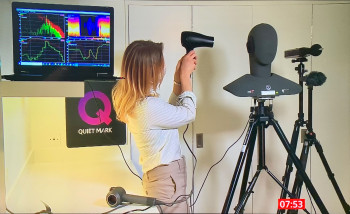
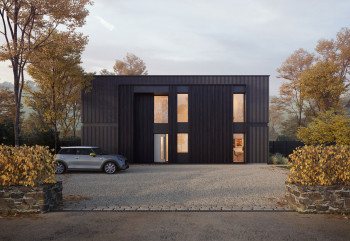
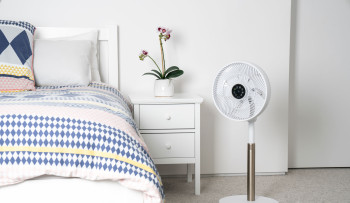
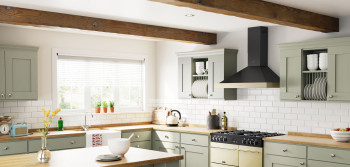







 Quiet Mark Founder
Quiet Mark Founder